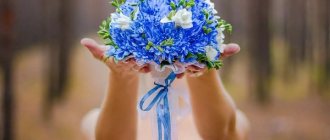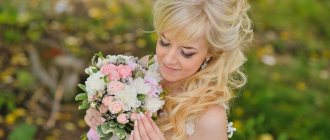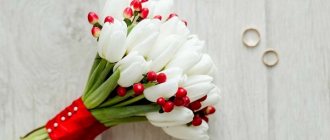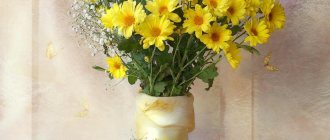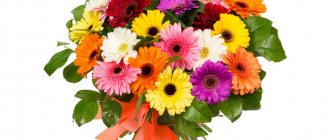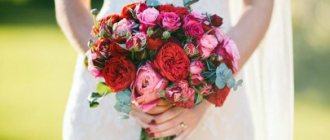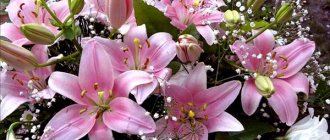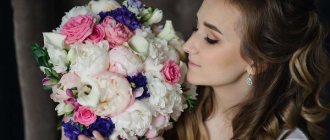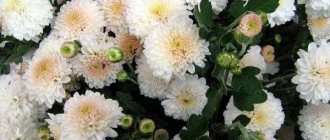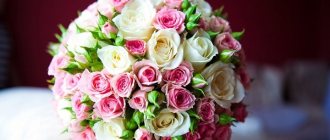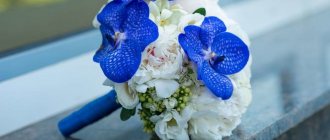Symbolism
The fluffy, graceful flower came to us from the east , from China and Japan, where it symbolizes the sun, imperial power, fortitude and nobility. Interesting! Initially, the flowers were exclusively yellow in color, and therefore they were called golden.
It was believed that if the bride herself made a bouquet of these sunny buds, then her marriage would be blessed in heaven. Modern floristry interprets the meaning of chrysanthemums as resistance to any challenge, loyalty to each other and the spiritual strength of newlyweds.
Symbolic meaning
It is nice to receive even a simple bouquet of chrysanthemum roses as a gift, as it symbolizes joy, prosperity and longevity. If you want to give a flower tandem a special meaning, you need to carefully select the shades of the buds. Often, royal beauties themselves have one meaning, but together they speak of something else.
The following table will reveal the nuances of the subtle language of floral symbolism.
| Roses | Chrysanthemums | In composition |
| Red - passion, strong love, admiration for the object of feelings. | Yellow - in the east means success, wisdom, wealth, health. | An offer of marriage. |
| White – innocence, purity of feelings, fidelity. | Devotion, sincerity of intentions, impeccability. | They symbolize the best feminine qualities of the bride. |
| Pink – tenderness, coquetry, easy falling in love, romance, freshness and youth | Lilac, lilac, pale blue - sympathy, friendliness, desire to show care. | Gifted at the beginning of a relationship. Good for a first date. |
Advantages
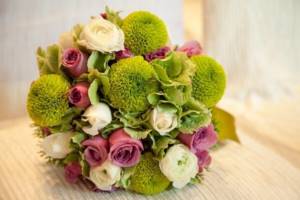
The advantages of chrysanthemums include:
- hardiness , these flowers will withstand both frost and scorching sun, and therefore they are used at weddings all year round;
- a huge palette of shades and varieties , allowing you to choose something to suit every bride’s taste;
- good compatibility with other plants : chrysanthemums are absolutely not jealous;
- long life : for another two weeks after the celebration, the inflorescences will continue to delight you with their fresh appearance and enchanting aroma;
- universal appearance , suitable for any look: from classic to stylized;
- availability throughout the year;
- budget.
Photos of bride's wedding bouquets made of chrysanthemums
Touching chrysanthemums with a delicate aroma in the bride's accessory go well with other plants - roses, lilies, alstroemerias, peonies, hydrangeas, eustomas, gerberas, carnations. The bouquet can also be decorated with decorative details - for example, artificial berries, butterflies, beads, dry branches. Find ideas for creating a chrysanthemum flower arrangement in the selection of photos presented below:
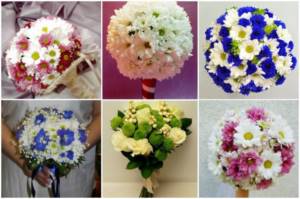
What kind of brides is it suitable for?
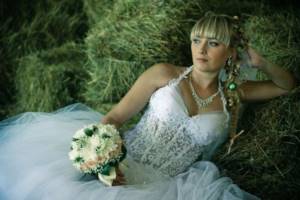
- Gentle, dreamy natures will like pastel and light shades;
- Bright optimists will like compositions of orange or red inflorescences;
- Creative young ladies will appreciate the cool spectrum of colors - blue, blue, violet tones.
Due to their hardiness, chrysanthemums are the best option for brides who want to make their own wedding bouquet - the buds will withstand any experimentation. Also, flowers look great at any time of the year. In winter, they are not afraid of frost and contrast effectively with the snow-white snow. Pastel shades are chosen for spring, bright and rich – for celebrations in the hot summer, warm – for golden autumn.
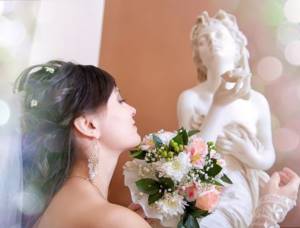
Options for combining chrysanthemums with other flowers
A mono bouquet always looks gentle and elegant. However, if you want to create a truly creative image, you should experiment and combine chrysanthemum with other flowers .
Roses and alstroemerias
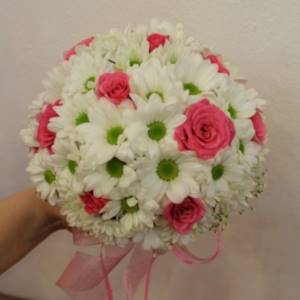
Unusual bridal bouquet: roses and chrysanthemums. With the help of such an original combination of several plants, we can say that the young lady is energetic and cheerful. She is not afraid to experiment and try new things in life. Her main motto is bright and rich colors in life. Alstroemerias in this bouquet are only inflorescences with buds.
They look like unopened flowers. But roses, with their lush and fragrant buds, seem to remind of the elegance of the bride. Chrysanthemums in this combination speak of tenderness of character.
Gerberas
They were grown in hot Africa. Looking at them, it seems that the flowers have absorbed all the sultry sun. It is unlikely that you will be able to find muted tones of gerberas. Basically, these are rich and cheerful colors. Combining them with chrysanthemums, you get a truly lively and sunny bouquet.
If the bride is always positive and strives to create a cheerful and happy family, then she will definitely choose this combination.
Carnations
An unconventional combination of two plants. Unfortunately, it is generally accepted that the carnation is more of a mourning flower than a festive flower. Breeders propose to change the attitude towards it. One has only to look and be surprised at the variety of color palette it represents. The carnation is the very first symbol of love.
According to one legend, it was the carnation that bloomed on the birthday of Jesus Christ. This is a believing flower that has absorbed universal love, humility, mutual understanding and respect. Chrysanthemums and carnations are the best way to express how innocent and touching the bride is.
Roses
Roses are rightfully considered the royal flowers. They combine perfectly and suit many plants. Shrub roses in white, peach and pearlescent shades will create a romantic mood and highlight the bride’s character.
Palette of shades and their meaning
If earlier chrysanthemums were presented only in the yellow version, then modern floristry has developed a variety of varieties to suit every taste. Each shade complements the overall interpretation of the overall meaning of the bouquet:
- White chrysanthemums traditionally mean purity and innocence, the beginning of a new family life for the bride;
- Red flowers symbolize strong passion, attraction to each other through time and space;
- Yellow petals are closest to the traditional ancient interpretation - well-being in every sense: from divine blessing to financial independence;
- The blue color speaks of lightness, happiness, and an optimistic view of the future;
- Pink symbolizes tenderness, romantic love, caring for each other;
- Purple or lilac flowers emphasize the bride's originality and creativity.
Master class on spiral technology
Spiral technology is easy to transport and hand to the recipient. The composition fits well into a vase or even a bucket, in the case of a large number of bouquets presented at the same time.
For the spiral composition you need to prepare:
- large white roses;
- small green and pink chrysanthemums on branches;
- ruscus greens;
- multi-colored eustomas;
- bush blue carnations;
- wide tape for fixation;
- interlining.
First, let's take a few different flowers and a sprig of ruscus greens. Let's place them harmoniously relative to each other. This will be the center of the future bouquet.
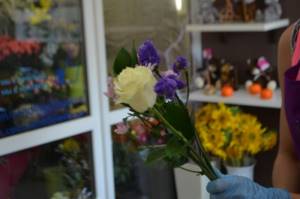
We alternately place carnations, roses, and eustomas of different shades so that neighboring plants differ in color and shape. We place the plant stems not strictly vertically, but at a slight angle. We twist each next row in a spiral.
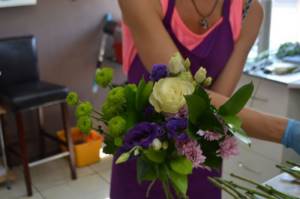
We tie the stems with decorative tape, pulling them tightly together. For small compositions you will need only 4-5 turns, and for large and heavy ones at least 10.
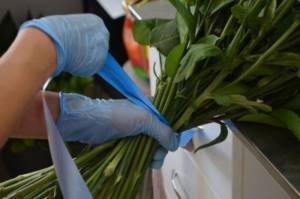
Using pruning shears, we give the same length to all stems so that the bouquet looks neat and tidy.
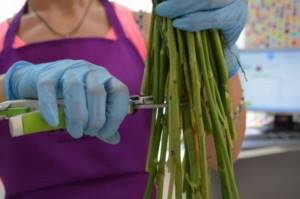
The composition using the spiral technique is stable even without a vase; it has the correct balancing and center of gravity.
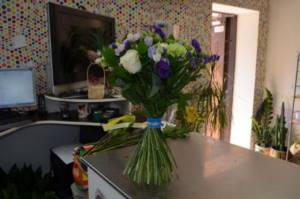
To complete the look, we will pack the bouquet in several layers of non-woven fabric, which will highlight the entire color scheme of the composition. Tie the outer edge with bright ribbon or raffia.
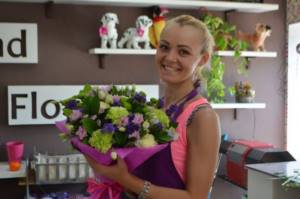
Wedding composition ideas
Chrysanthemums are divided into two large groups of varieties - bush and single-headed.
The first are branches with several miniature inflorescences. They look more natural, cute, and are perfect for compositions for a rustic or Provençal celebration.
The second are larger single buds on a strong long stem. They can be assembled into a round, cascading, or elongated shape.
The petals of both varieties can be double, smooth, curled or long.
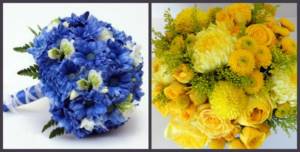
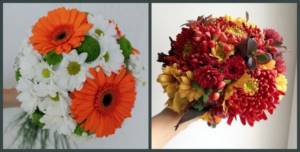
Any variety looks great in a mono-bouquet, but if desired, the flower can easily be combined with any plants : from royal roses, orchids or lilies to more democratic ones - eustoma, peonies, alstroemeria, tulips, hydrangea.
Idea! Bacardi bush chrysanthemums look interesting - they look like a large rounded daisy, and therefore go perfectly with gerberas or wildflowers.
If you want to create a truly unusual composition, then feel free to combine succulents, pine branches, and dried flowers with chrysanthemums.
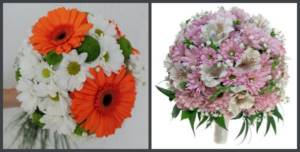
Bush varieties
Varieties with several inflorescences look very feminine, gentle and natural. Making a solo composition out of them is an excellent choice for both a variety of natural or vintage weddings, and for a completely classic celebration.
It is permissible to use several types of plants, different shades or shapes. This will add texture and bright colors to the bouquet, and will also allow you to play with interpretations and associations.
Try not to take more than three pure colors at a time, and green also counts. It is permissible to add more shades, but in any case, remember about moderation, because the bouquet should only emphasize the beauty of the bride, and not draw all the attention to itself.
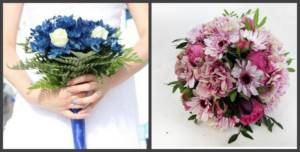
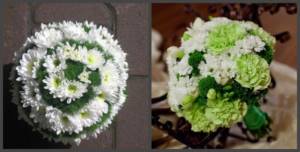
An equally charming option is possible when using one color. White, cream, pink spray chrysanthemums will create a romantic and reverent image.
They don't need a lot of decoration. It is enough just to intercept the stems with a satin ribbon, lace, or a string of beads. A blue, blue, purple bouquet will perfectly highlight a snow-white dress and become a bright and sophisticated accent. A completely green composition is suitable for an eco-style wedding. In this case, you can use ordinary gray or brown twine as decoration - you will get a fresh and unusual picture.
If you want to add something else to the airy fluffy petals, then spray chrysanthemums look interesting with peonies, gypsophila, and hydrangea. A more sophisticated combination can be achieved by combining fluffy inflorescences with roses : small, large or vintage David Austin varieties.
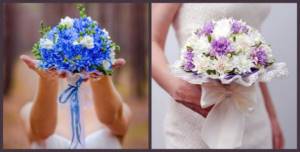
Small flowers
Small inflorescences of chrysanthemums wonderfully fit into a round, spherical or hemispherical composition , creating a truly solid, delicate and airy accessory.
Idea! Very interesting are chrysanthemums that combine several shades, with a yellow core or with a border. They add texture and necessary accents to the bouquet.
For an unusual composition, you can choose the shape of a pomander - a sphere without a leg, attached to a satin ribbon. The accessory can be worn on your hand, which is quite convenient if you plan to move a lot, but do not want to leave the bouquet in the vase.
Compositions made from both white and colored chrysanthemums look funny. If you choose the most saturated or dark color - burgundy, scarlet, purple, then we recommend using the same shade in any other detail of the image - lipstick, hairpin, shoes. This will allow you to create a single harmonious composition.
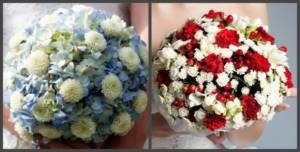
Roses
The Queen of Flowers looks great framed by delicate chrysanthemums. It is better to use large rose buds as the main accent of the composition, and dilute bush roses with chrysanthemums in equal proportions.
Neat, elegant petals of larger pink buds will add aristocracy to the overall picture , regardless of whether the bouquet is monochrome or multi-colored.
A contrasting combination of scarlet or blue with white will suit bright, emotional girls who are not afraid to show feelings. Completely pink compositions look beautiful with pearl decor, and you can glue them directly onto flowers. An absolutely green or blue bouquet will appeal to extraordinary, creative people.
Roses are not very fond of their neighbors in a vase, poisoning them with toxic substances. Therefore, if you want the bouquet to please you longer, separate the flowers and place them in different containers after the wedding.
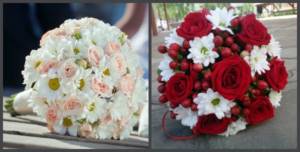
Eustoma
Eustoma is similar to a rose, but has a more democratic character and tenderness of form. A huge palette of shades allows you to select exquisite combinations - for example, from plants with the same gradient color.
Important! Eustoma, like chrysanthemum, is a hardy plant, so such a bouquet will definitely withstand even the longest wedding day.
Completely white bouquets interspersed with yellow or green hearts look no less chic. If you choose large, single-headed chrysanthemums, the bouquet will be more uniform and harmonious , but if you choose small, bush chrysanthemums, then it is better to place them along the edges, giving the leading role to the captivating petals of the eustoma.
Typically, delicate shades of pink or cream with a contrasting combination of yellow, red, blue or green chrysanthemums are used for weddings, but the opposite is also acceptable. Flaming scarlet or deep blue eustoma on the airy petals of white chrysanthemums is no less a stunning sight.
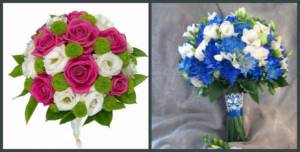
Roses and alstroemeria
Similar to small lilies, alstroemerias come in a wide variety of colors. Often their color combines several shades due to spots, stripes, and edging of the petals. The trio of these exotic plants with elegant roses and delicate chrysanthemums creates truly magical pictures.
It is very important not to overdo it with the number of shades, otherwise the bouquet will turn out too chaotic. A good idea is a cascade form with an abundance of greenery and small islands of buds of different types, but of the same shade. Very miniature bouquets with literally one large rose and a frame of several chrysanthemums and alstroemerias also look great.
Be sure to take into account the theme of the wedding, as some chic options look organic only if properly framed. First of all, these are rich dark tones of crimson, violet, and red. For a classic wedding, it is better to stick to pastel, powdery tones of white and pink.
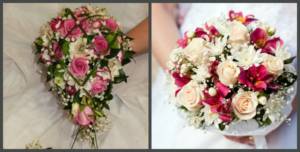
Gerberas
Optimistic round gerberas symbolize joy, openness and at the same time emphasize the modesty of the bride. In a duet with chrysanthemums, these playful flowers are ready to act as both a bright accent and an equal participant, depending on the chosen color scheme and varieties.
A mono-bouquet in which gerberas and chrysanthemums differ from each other by a tone or two looks interesting. Such ensembles are made in both delicate and bright colors.
In the case of a completely white composition, we strongly recommend adding at least a little greenery so that the accessory has borders. This way it won’t blend in with the bride’s dress.
Since both plants are distinguished by strong, long stems, a bouquet of any shape is possible - round, cascading, scepter. The endurance of the petals will make the composition quite viable in specific forms - a fan or a pomander.
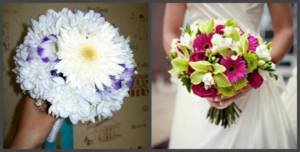
Carnations
Carnations are not the most frequent guest in wedding bouquets, but such neglect is completely undeserved, because the flower is distinguished by both its cute appearance and excellent resistance to cold, heat and drought. That is why a duet of carnations and chrysanthemums will be a real salvation for a winter or autumn wedding.
Advice! Cloves have a spicy and quite strong aroma, so if you don’t want it to overpower the smell of chrysanthemums, then choose white and pastel flowers. They smell weaker.
There is also the opportunity to show imagination in choosing a color palette. Carnations come in two colors, striped, and with a border. An interesting idea is to select a second flower to match the color of the neighbor’s stripes or core. The stem of the bouquet should be decorated with ribbons of both colors. Carnations also do well in pomander.
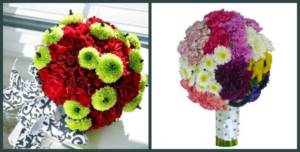
How to make a bouquet of gerberas and chrysanthemums with your own hands
You will need:
- 5 large-headed gerberas of any colors, possible in one color
- 4 branches of spray white chrysanthemums
- 1-2 branches of gypsophila
- 4 sprigs of fern to decorate the bouquet
- scissors
- ribbon for bouquet bunching
Action plan:
- Take gypsophila - this will be the center of your bouquet. Place the gerbera inside. It’s good if the gypsophila branch is highly branched, then the bouquet will look more alive. Otherwise, it makes sense to take 2 branches of this greenery.
- Attach a chrysanthemum branch to the center of the future composition.
- Next is another gerbera. Remember to lay the flowers in a spiral and slightly at an angle, this will prevent the stems from breaking.
- Arrange flowers in this sequence and in a checkerboard pattern - especially if your gerberas are of different shades.
- Trim the flowers to form a clear circle. Gypsophila, on the contrary, needs to be raised above the rest - it serves the decorative function of a wedding bouquet.
- Place the fern symmetrically opposite each of the four gerberas along the edges (if you did everything correctly, the fifth one should be in the center).
- Tie all the flowers together so that the bouquet does not fall apart with a ribbon. You can take any, but if it is thin, it is better to grab the stems again lower by 5-7 cm to be safe.
- Trim flowers to a manageable length.
- Decorate the bouquet as you wish with decorative pins or ribbons. Ready!
How to keep it fresh?
Chrysanthemums are resistant to negative external influences , but any flowers are delicate creatures and love to be cared for. To ensure that your bouquet pleases you for as long as possible, we recommend using a few simple rules:
- Before putting chrysanthemums in water, be sure to treat the stems . Trim the bottom edge at an angle with a sharp knife or pruning shears, but never with scissors. You need to remove about 3 cm;
- All leaves that are below the water level must be removed , otherwise they will begin to rot;
- To create a bouquet, use already opened inflorescences , rather than buds, which dry out and wither faster;
- Do not place the vase in direct sunlight or drafts;
- Remove wilted plants in a timely manner , otherwise they will begin to poison their healthy counterparts;
- If the bouquet nevertheless begins to fade quickly, do not despair, because chrysanthemums can be revived . To do this, alternately place the flowers in hot and cold water for several minutes, then cut off another 5 cm of stems and place in a vase with water at room temperature;
- Another way is to feed cut flowers , which should be poured directly into a container of water. This could be a specialized mixture, regular sugar, or an aspirin tablet.
Minimalism for the discerning person
The combination of white roses and green chrysanthemums in a multi-level bouquet reveals the beauty of each element. Including leafy plants will complete the look, making it complete. To create a composition you will need:
- white roses 5 pcs;
- aspidistra greens;
- sprigs of green chrysanthemum 2-4 pieces, depending on the density of the inflorescences;
- phoenix leaf;
- green tape;
- ribbon for decoration;
- pruning shears or florist knife;
- organza: white, creamy pink or soft green.
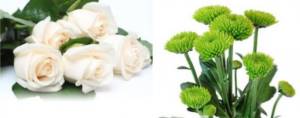
Step-by-step instructions for creating a vertical composition:
- We prepare roses by cutting stems of different lengths: leave one as long as 45-50 cm, two – 35-30, two – 10-15. The cuts are made with a knife or pruning shears at an acute angle. Leave the flowers in the vase to saturate them with moisture.
- We shorten the branches of chrysanthemum, aspidistra, and phoenix in height.
- We place a phoenix leaf on the table. Place the longest rose on top, then two with shorter stems. On the third row we place green chrysanthemums, and below are the shortest roses. We connect all the elements using tape, tightening them tightly to make the structure static.
- We lay aspidistra leaves along the outer edge, folding some of them in half.
- We decorate the bottom using organza or other packaging material. We fold the material in several layers to increase density.
- We fix the lower part of the bouquet by wrapping it with decorative ribbon. If desired, tie a beautiful bow or leave the edges hanging freely.
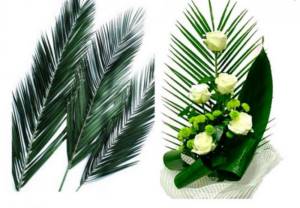
Photo
A wedding bouquet of chrysanthemums is suitable for gentle, romantic natures; this accessory will make the newlywed’s image touching and sweet. Several options for compositions using this plant are in the photo:
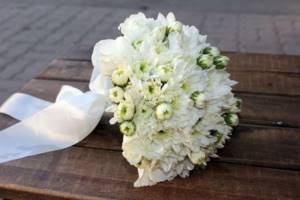
Features and Benefits
Chrysanthemum is ubiquitous and an unpretentious flower that is easy to grow in your own garden. This also has a positive effect on its cost; a bouquet of chrysanthemums will cost less than the option with capricious and exotic orchids and lilies. This flower looks beautiful in any composition; it has become a favorite of florists and decorators. Chrysanthemums are easy to work with; they have strong and dense stems that still remain flexible. In addition, there are the following advantages: Variety. You can put together a bouquet of different chrysanthemums, and no one will guess that they are flowers of the same species. They can look like daisies, peonies, gerberas, and there are a huge number of color variations. For example, a snow-white chrysanthemum looks very gentle and airy, while a burgundy one looks pretentious and solemn.
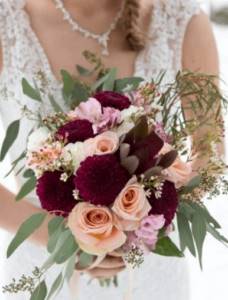
- Persistence. Cut flowers do not fall off for a very long time and tolerate both heat and cold well. If you have a long photo shoot on the street, you can rest assured that the bouquet will survive any walk and remain unchanged.
- Long flowering period. One bush can bloom for a month; different varieties have buds at different times, from July to October. During the rest of the year, chrysanthemums grow in a greenhouse, which does not affect their quality.
- Versatility. Chrysanthemum is perfect for creating a round bouquet and for a cascading composition. Its flowers can be of various sizes - from small flowers to large spherical inflorescences up to 15 centimeters in diameter.
A special feature of chrysanthemums is their aroma. The smell of flowers is memorable, with a slight bitterness. Many people really like it, but there are also those who may find it intrusive. For a small bouquet this is not critical, but for those who want to order a voluminous one, it is better to approach the decision carefully. Complex essential oils are responsible for the aroma of flowers, which can trigger an allergy attack in allergy sufferers.
